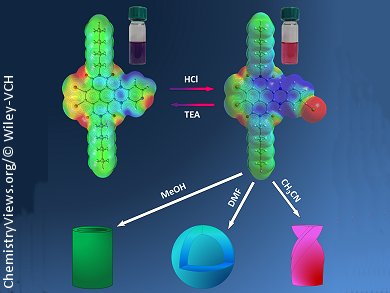Core-substituted naphthalene diimides (cNDIs) have opened new doors to various fields of chemistry by combining optical and structural changes to develop functional supramolecular nanostructures and ion sensors. Sheshanath V. Bhosale and his group in the School of Applied Sciences at the Royal Melbourne Institute of Technology (RMIT University), Australia, have developed a pyridyl-monoannulated cNDI complex that undergoes self-assembly into a variety of nanostructures such as flakes, tubules, ropes, and aggregates, the morphology of which is dependent on pH and solvent polarity.
The complex is also very sensitive to HCl, even in the ppm range, undergoing a colour change from blue to red. The protonation, which is fully reversible through the addition of a base, has been studied by UV/Vis and fluorescence spectroscopy. The long-wavelength absorption and emission close to the infrared region of the spectrum may lead to applications as a pH indicator for bioprocessing, as well as in medicinal and photonic materials.
- A Pyridyl-Monoannulated Naphthalene Diimide Motif Self-Assembles into Tuneable Nanostructures by Means of Solvophobic Control,
S. V. Bhosale, M. Adsul, G. V. Shitre, S. R. Bobe, S. V. Bhosale, S. H. Privér,
Chem. Eur. J. 2013.
DOI: 10.1002/chem.201300120




